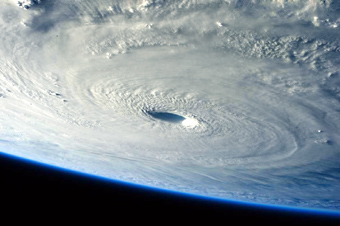
Typhoon Maysak, Seen From Space
| published April 1, 2015 |
By Thursday Review staff
It became official yesterday (March 31): Typhoon Maysak is now a super-typhoon, that rarest of storms which exceeds specific speeds and power on the Saffir-Simpson Wind Scale, the standard rating process used to define the strength of cyclones, hurricanes, tropical storms and typhoons. Among other identifying factors, Saffir-Simpson is used to predict property damage, injury and loss of life.
In this striking NASA photograph, Maysak can be seen in classic cyclonic grandeur over the Pacific Ocean, where it has already caused at least five deaths in Micronesia, and where it now has a direct bead on The Philippines. Though its wind speeds were even higher over open ocean, the National Weather Service’s Guam office says its wind speed has decreased slightly, to 150 mph. Typhoons which have a sustained wind speed of more than 150 mph are usually automatically kicked up to “super typhoon” status. According to several meteorological services, Maysak is only the second pre-April 1 typhoon to reach such a level of power since 2002.
According to NASA, and several weather services in Japan and The Philippines, Maysak’s thunderstorm activity is gaining momentum, and its wind speeds may once again rise above 150 mph.
This photograph was taken from the International Space Station as it passed over the Pacific Ocean late on March 31 (early April 1 in the Pacific). The space station flew directly above the massive storm, capturing imagery and collecting data to be synthesized and analyzed by on Earth.
In the Philippines, preparations are under way to brace for Maysak’s impact later this week. The Weather Channel indicates that data collected from various weather services show the storm may lose some speed before making landfall, possibly late Saturday night, but that residents in the northern Philippines, especially in Luzon, should be prepared and take precautions.
Related Thursday Review articles:
Expedition 43: One Year in Space; Thursday Review; March 29, 2015.
